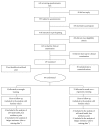Strength Training Improves Fatigue Resistance and Self-Rated Health in Workers with Chronic Pain: A Randomized Controlled Trial
- PMID: 27830144
- PMCID: PMC5086514
- DOI: 10.1155/2016/4137918
Strength Training Improves Fatigue Resistance and Self-Rated Health in Workers with Chronic Pain: A Randomized Controlled Trial
Abstract
Chronic musculoskeletal pain is widespread in the working population and leads to muscular fatigue, reduced work capacity, and fear of movement. While ergonomic intervention is the traditional approach to the problem, physical exercise may be an alternative strategy. This secondary analysis of a randomized controlled trial investigates the effect of strength training on muscular fatigue resistance and self-rated health among workers with chronic pain. Sixty-six slaughterhouse workers with chronic upper limb pain and work disability were randomly allocated to 10 weeks of strength training or usual care ergonomic training (control). At baseline and follow-up, participants performed a handgrip muscular fatigue test (time above 50% of maximal voluntary contraction force) with simultaneous recording of electromyography. Additionally, participants replied to a questionnaire regarding self-rated health and pain. Time to fatigue, muscle strength, hand/wrist pain, and self-rated health improved significantly more following strength training than usual care (all P < 0.05). Time to fatigue increased by 97% following strength training and this change was correlated to the reduction in fear avoidance (Spearman's rho = -0.40; P = 0.01). In conclusion, specific strength training improves muscular fatigue resistance and self-rated health and reduces pain of the hand/wrist in manual workers with chronic upper limb pain. This trial is registered with ClinicalTrials.gov NCT01671267.
Figures



References
-
- Bernard B. Musculoskeletal Disorders and Workplace Factors: A Critical Review of Epidemiologic Evidence for Work-Related Musculoskeletal Disorders of the Neck, Upper Extremity, and Low Back. US Department of Health and Human Services Public Health Services, Centers for Disease Control and Prevention, The National Institute for Occupational Safety and Health; 1997.
Publication types
MeSH terms
Associated data
LinkOut - more resources
Full Text Sources
Other Literature Sources
Medical

